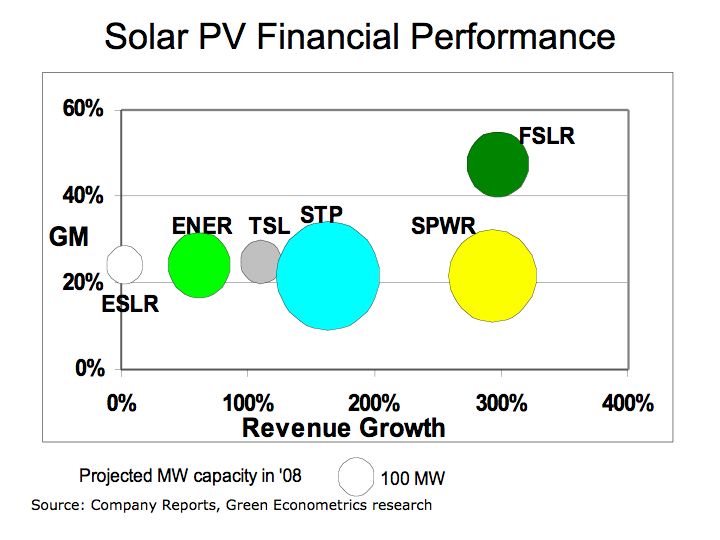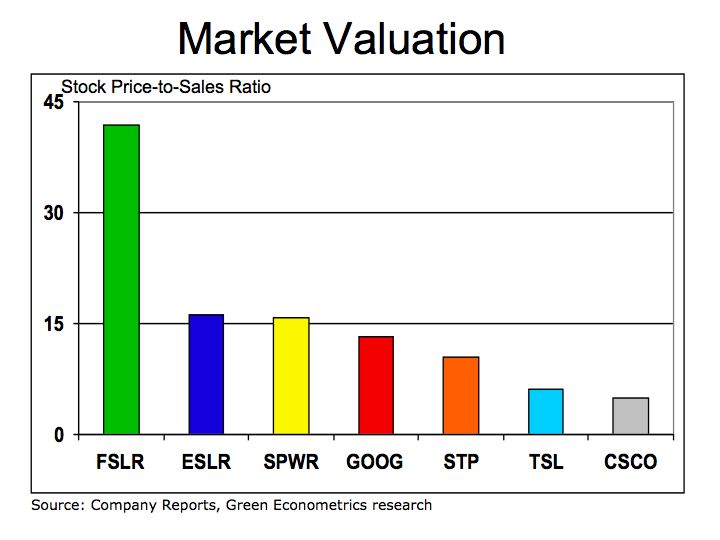Economics of Solar PV Suppliers
Improving economics and high market valuations should help drive research for alternative energy. With the release of Q3/07 financials, it’s clear that the economics of solar photovoltaic (PV) suppliers is improving. Some of the leading pure play publicly traded PV stocks are demonstrating significant improvements in financial performance that should drive further investment into solar and green technology. The improving economics of solar should continue to drive further investment into alternative energy companies as venture capital firms and Wall Street find that alternative energy is a significant secular trend with sustainable economic foundation.
Most visible among the solar PV suppliers is First Solar (FSLR) with y/y revenue growth for Q3/07 increasing 290% and gross margins exceeding 50% and operating margins above 30%. FSLR’s management was clear in articulating that these strong Q3 numbers reflect ramping on of its German manufacturing facility and would not be sustainable. However, with gross margins exceeding 50% and operating margins above 30% Wall Street takes notice and rewards the firm with valuation multiple envious of leading technology companies such as Google (GOOG) and Cisco Systems (CSCO).
Figure 1 Revenues, Margins, and Capacity

The stronger financial performance of solar PV suppliers is significant because it improves the viability of the solar PV business model thereby attracting more investors and in turn drives funding for alternative energy start up companies. FSLR went public in November 2006 with a closing price of $24.74 on its first day. With a closing price one year later of $212.63, FSLR offers investors a yearly return of 759%. The attractive return generated by solar stocks tends to attract more investors and drives market valuations higher thus feeding the flow of additional venture capital funding.
In terms of market valuation FSLR trades at a significant premium to most companies in the S&P 500 as well as leading technology companies including GOOG and CSCO. . Most solar PV companies trade at higher market valuation multiples than CSCO and GOOG. Both FSLR and Sun Power (SPWR) trade at premium price-to-sales (P/S) and price/earnings-to-growth (PEG) multiples in comparison to some leading technology stocks. In terms of PEG ratios, FSLR and SPWR trade at 2.9x and 2.2x respectively while CSCO and GOOG trade at 1.3x and 1.2X, respectively. In comparison, the S&P 500 index trades at a PEG of 0.8x while the technology and energy segments trade at 0.6x and 2.2x, respectively. These high market valuations prove the venture capital community with high exit values on their current crop of alternative energy investments. Please see Figure 2.
It is this premium market valuation multiple that suggests the importance of alternative energy. Wall Street tends to be a leading indicator and keen in its ability to identify secular trends. Major trends command premium valuations and reward venture capital with attractive exist strategies. Wall Street rewards cash flow growth fueling further venture capital funding that in turn, fuels the flow of intellectual and financial capital. The value migration measured by price-to-sales multiples and illustrated by A. Slywotsky in his book Value Migration provide a framework to gauge the significance of trend towards alternative energies. Capital gravitates to the business model that creates economic value and is measured by a stock’s price-to-sale ratio. By that measure solar stocks is where the value is headed.
Figure 2 Price-to-Sales Ratio

The bottom line is that high market valuations attract research funding and brain power. Rising oil prices, rapid industry growth, and high public market valuations of solar PV companies, should act to attract further venture capital funding of alternative energy companies. Increased solar funding should translate into increased research and talent migration that could improve solar efficiency and reduce costs that in turn could bring solar to electric grid parity.
Related Posts